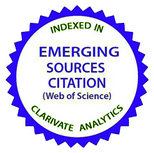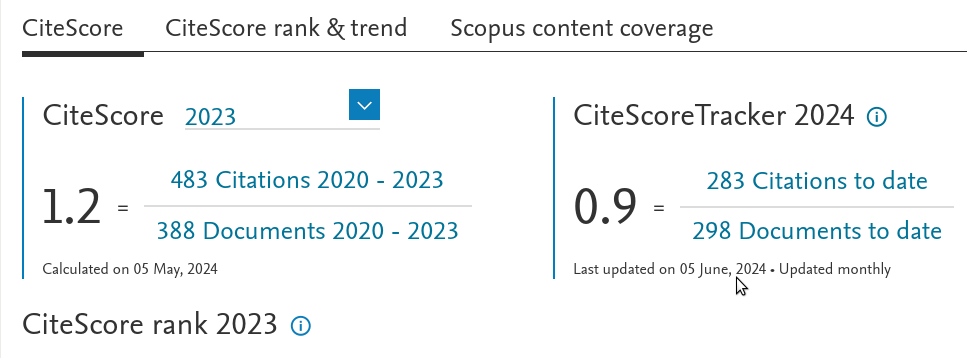Фазовий перехід першого роду в рамках коміркової моделі плину: області зміни хімічного потенціалу та відповідні густини
DOI:
https://doi.org/10.15407/ujpe67.1.54Ключові слова:
комiркова модель плину, хiмiчний потенцiал, густина, рiвняння стану, бiнодальАнотація
Роботу присвячено мiкроскопiчному опису поведiнки плинного середовища в безпосередньому околi критичної точки, де теоретичнi та експериментальнi дослiдження важко проводити. Для температур T < TC видiлено i проаналiзовано областi змiни хiмiчного потенцiалу та густини. Рiвняння стану комiркової моделi плину у змiнних температура–хiмiчний потенцiал записано з використанням функцiй Хевiсайда. Дане рiвняння подано також у термiнах змiнних температура–густина. В результатi дослiдження зв’язку мiж густиною та хiмiчним потенцiалом отримано рiвняння для бiнодалi в безпосереднiй близькостi до критичної точки.
Посилання
C.-L. Lee, G. Stell, J.S. Høye. A simple SCOZA for simple fluids. J. Mol. Liq. 112, 13 (2004).
https://doi.org/10.1016/j.molliq.2003.11.004
C.E. Bertrand, J.F. Nicoll, M.A. Anisimov. Comparison of complete scaling and a field-theoretic treatment of asymmetric fluid criticality. Phys. Rev. E 85, 031131 (2012).
https://doi.org/10.1103/PhysRevE.85.031131
A. Parola, L. Reatto. Recent developments of the hierarchical reference theory of fluids and its relation to the renormalization group. Mol. Phys. 110, 2859 (2012).
https://doi.org/10.1080/00268976.2012.666573
I.R. Yukhnovskii. The phase transition of the first order in the critical region of the gas-liquid system. Condens. Matter Phys. 17, 43001 (2014).
https://doi.org/10.5488/CMP.17.43001
T.J. Yoon, Y.-W. Lee. Current theoretical opinions and perspectives on the fundamental description of supercritical fluids. J. Supercrit. Fluids 134, 21 (2018).
https://doi.org/10.1016/j.supflu.2017.11.022
L.F. Vega. Perspectives on molecular modeling of supercritical fluids: From equations of state to molecular simulations. Recent advances, remaining challenges and opportunities. J. Supercrit. Fluids 134, 41 (2018).
https://doi.org/10.1016/j.supflu.2017.12.025
A. Oleinikova, L. Bulavin, V. Pipich. Critical anomaly of shear viscosity in a mixture with an ionic impurity. Chem. Phys. Lett. 278, 121 (1997).
https://doi.org/10.1016/S0009-2614(97)00945-7
S. Pittois, B. Van Roie, C. Glorieux, J. Thoen. Thermal conductivity, thermal effusivity, and specific heat capacity near the lower critical point of the binary liquid mixture n-butoxyethanol-water. J.Chem. Phys. 121, 1866 (2004).
https://doi.org/10.1063/1.1765652
M.P. Kozlovskii, I.V. Pylyuk, O.A. Dobush. The equation of state of a cell fluid model in the supercritical region. Condens. Matter Phys. 21, 43502 (2018).
https://doi.org/10.5488/CMP.21.43502
I.V. Pylyuk. Fluid critical behavior at liquid-gas phase transition: Analytic method for microscopic description. J. Mol. Liq. 310, 112933 (2020).
https://doi.org/10.1016/j.molliq.2020.112933
M. Kozlovskii, O. Dobush. Representation of the grand partition function of the cell model: The state equation in the mean-field approximation. J. Mol. Liq. 215, 58 (2016).
https://doi.org/10.1016/j.molliq.2015.12.018
M.P. Kozlovskii, O.A. Dobush, I.V. Pylyuk. Using a cell fluid model for the description of a phase transition in simple liquid alkali metals. Ukr. J. Phys. 62, 865 (2017).
https://doi.org/10.15407/ujpe62.10.0865
I.V. Pylyuk, O.A. Dobush. Equation of state of a cell fluid model with allowance for Gaussian fluctuations of the order parameter. Ukr. J. Phys. 65, 1080 (2020).
https://doi.org/10.15407/ujpe65.12.1080
I.R. Yukhnovskii. Phase Transitions of the Second Order. Collective Variables Method (World Scientific, 1987).
J.K. Singh, J. Adhikari, S.K. Kwak. Vapor-liquid phase coexistence curves for Morse fluids. Fluid Phase Equilib. 248, 1 (2006).
https://doi.org/10.1016/j.fluid.2006.07.010
E.M. Apfelbaum. The calculation of vapor-liquid coexistence curve of Morse fluid: Application to iron. J. Chem. Phys. 134, 194506 (2011).
https://doi.org/10.1063/1.3590201
Y. Zhou, M. Karplus, K.D. Ball, R.S. Berry. The distance fluctuation criterion for melting: Comparison of squarewell and Morse potential models for clusters and homopolymers. J. Chem. Phys. 116, 2323 (2002).
https://doi.org/10.1063/1.1426419
X. Xu, C. Cheng, I.H. Chowdhury. Molecular dynamics study of phase change mechanisms during femtosecond laser ablation. J. Heat Transfer 126, 727 (2004).
https://doi.org/10.1115/1.1797011
I. Last, Y. Levy, J. Jortner. Beyond the Rayleigh instability limit for multicharged finite systems: From fission to Coulomb explosion. Proc. Natl. Acad, Sci. USA 99, 9107 (2002).
https://doi.org/10.1073/pnas.142253999
J.P.K. Doye, D.J. Wales. The structure and stability of atomic liquids: From clusters to bulk. Science 271, 484 (1996).
https://doi.org/10.1126/science.271.5248.484
J.P.K. Doye, R.H. Leary, M. Locatelli, F. Schoen. Global optimization of Morse clusters by potential energy transformations. INFORMS J. Comput. 16, 371 (2004).
https://doi.org/10.1287/ijoc.1040.0084
A. Tekin, M. Yurtsever. Molecular dynamics simulation of phase transitions in binary LJ clusters. Turk. J. Chem. 26, 627 (2002).
C.-I. Chou, C.-L. Ho, B. Hu, H. Lee. Morse-type Frenkel-Kontorova model. Phys. Rev. E 57, 2747 (1998).
https://doi.org/10.1103/PhysRevE.57.2747
A. Strachan, T. Cagin, W.A. Goddard, III. Phase diagram of MgO from density-functional theory and moleculardynamics simulations. Phys. Rev. B 60, 15084 (1999).
https://doi.org/10.1103/PhysRevB.60.15084
T.-C. Lim. Approximate relationships between the Generalized Morse and the Extended-Rydberg potential energy functions. Acta Chim. Slov. 52, 149 (2005).
A. Del Sol Mesa, C. Quesne, Yu.F. Smirnov. Generalized Morse potential: Symmetry and satellite potentials. J. Phys. A 31, 321 (1998).
https://doi.org/10.1088/0305-4470/31/1/028
P.M. Morse, E.C.G. Stueckelberg. Diatomic molecules according to the wave mechanics I: Electronic levels of the hydrogen molecular ion. Phys. Rev. 33, 932 (1929).
https://doi.org/10.1103/PhysRev.33.932
A.S. Leal, C. Gouvea dos Santos, C.M. Quintella, H.H.R. Schor. A theoretical model for the scattering of I2 molecule from a perfluoropolyeter liquid surface. J. Braz. Chem. Soc. 10, 359 (1999).
https://doi.org/10.1590/S0103-50531999000500004
V. Constantoudis, C.A. Nicolaides. Stabilization and relative phase effects in a dichromatically driven diatomic Morse molecule: Interpretation based on nonlinear classical dynamics. J. Chem. Phys. 122, 084118 (2005).
https://doi.org/10.1063/1.1854631
A.I. Milchev, A.A. Milchev. Wetting behavior of nanodroplets: The limits of Young's rule validity. Europhys. Lett. 56, 695 (2001).
https://doi.org/10.1209/epl/i2001-00576-1
D. Osorio-Gonzalez, M. Mayorga, J. Orozco, L. RomeroSalazar. Entropy and thermalization of particles in liquids. J. Chem. Phys. 118, 6989 (2003).
https://doi.org/10.1063/1.1560933
P. Shah, C. Chakravarty. Instantaneous normal mode analysis of Morse liquids. J. Chem. Phys. 116, 10825 (2002).
https://doi.org/10.1063/1.1479714
H. Okumura, F. Yonezawa. Liquid-vapor coexistence curves of several interatomic model potentials. J. Chem. Phys. 113, 9162 (2000).
https://doi.org/10.1063/1.1320828
T.-C. Lim. The relationship between Lennard-Jones (12-6) and Morse potential functions. Z. Naturforsch. 58a, 615 (2003).
Downloads
Опубліковано
Як цитувати
Номер
Розділ
Ліцензія
Ліцензійний Договір
на використання Твору
м. Київ, Україна
Відповідальний автор та співавтори (надалі іменовані як Автор(и)) статті, яку він (вони) подають до Українського фізичного журналу, (надалі іменована як Твір) з одного боку та Інститут теоретичної фізики імені М.М. Боголюбова НАН України в особі директора (надалі – Видавець) з іншого боку уклали даний Договір про таке:
1. Предмет договору.
Автор(и) надає(ють) Видавцю безоплатно невиключні права на використання Твору (наукового, технічного або іншого характеру) на умовах, визначених цим Договором.
2. Способи використання Твору.
2.1. Автор(и) надає(ють) Видавцю право на використання Твору таким чином:
2.1.1. Використовувати Твір шляхом його видання в Українському фізичному журналі (далі – Видання) мовою оригіналу та в перекладі на англійську (погоджений Автором(ами) і Видавцем примірник Твору, прийнятого до друку, є невід’ємною частиною Ліцензійного договору).
2.1.2. Переробляти, адаптувати або іншим чином змінювати Твір за погодженням з Автором(ами).
2.1.3. Перекладати Твір у випадку, коли Твір викладений іншою мовою, ніж мова, якою передбачена публікація у Виданні.
2.2. Якщо Автор(и) виявить(лять) бажання використовувати Твір в інший спосіб, як то публікувати перекладену версію Твору (окрім випадку, зазначеного в п. 2.1.3 цього Договору); розміщувати повністю або частково в мережі Інтернет; публікувати Твір в інших, у тому числі іноземних, виданнях; включати Твір як складову частину інших збірників, антологій, енциклопедій тощо, то Автор(и) мають отримати на це письмовий дозвіл від Видавця.
3. Територія використання.
Автор(и) надає(ють) Видавцю право на використання Твору способами, зазначеними у п.п. 2.1.1–2.1.3 цього Договору, на території України, а також право на розповсюдження Твору як невід’ємної складової частини Видання на території України та інших країн шляхом передплати, продажу та безоплатної передачі третій стороні.
4. Строк, на який надаються права.
4.1. Договір є чинним з дати підписання та діє протягом усього часу функціонування Видання.
5. Застереження.
5.1. Автор(и) заявляє(ють), що:
– він/вона є автором (співавтором) Твору;
– авторські права на даний Твір не передані іншій стороні;
– даний Твір не був раніше опублікований і не буде опублікований у будь-якому іншому виданні до публікації його Видавцем (див. також п. 2.2);
– Автор(и) не порушив(ли) права інтелектуальної власності інших осіб. Якщо у Творі наведені матеріали інших осіб за виключенням випадків цитування в обсязі, виправданому науковим, інформаційним або критичним характером Твору, використання таких матеріалів здійснене Автором(ами) з дотриманням норм міжнародного законодавства і законодавства України.
6. Реквізити і підписи сторін.
Видавець: Інститут теоретичної фізики імені М.М. Боголюбова НАН України.
Адреса: м. Київ, вул. Метрологічна 14-б.
Автор: Електронний підпис від імені та за погодження всіх співавторів.

















